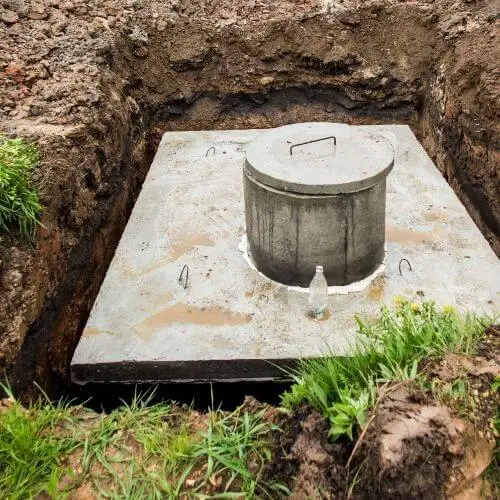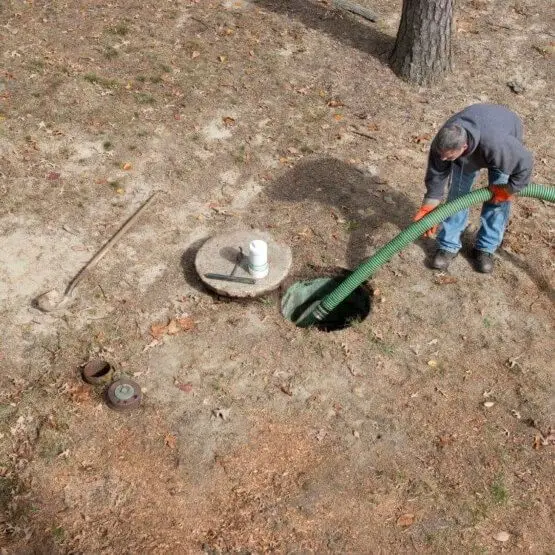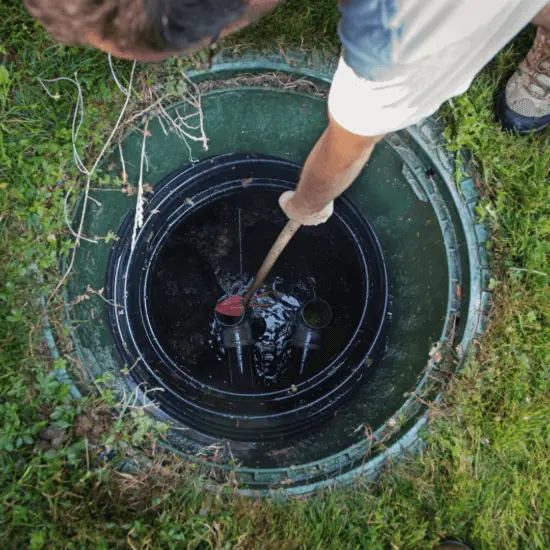Have you just had the septic tank pumped and full again and wondering what to do about it?
Pumping a septic tank is a dirty business. But it may be worse when it fills up again rapidly. A septic tank recently pumped but which fills up rapidly should be inspected.
There might be something wrong with the tank or drain field that needs to be fixed. The frequency at which the septic tank is pumped depends on its size and the volume of wastewater flowing through it.
If you just had the septic tank pumped and full again, you should find a way to fix the problem before it worsens.
What is a Septic Tank?

Septic tanks are large metal, plastic or concrete containers buried in the earth to treat household wastewater. One end of your tank connects to the home’s wastewater pipe, while the other drains into the drain field.
The septic tank has two chambers. Solids settle at the bottom of one section as wastewater runs through it, while scum rises to the top. Aerobic or anaerobic digestion helps to break down solid waste.[1]
More particles and scum are removed in the second chamber while liquid effluent flows through the drainpipe into the leach field. Finally, the wastewater is purified further by percolating through the soil in the drain field.
The intake and output pipes are the two most significant pipes in a septic tank. The input pipe sits about 3 inches above the outflow pipe, where wastewater joins the septic tank. Then, as the tank fills with liquid, it drains into the drain field through the output pipe.
The drain field is a disposal region where impurities in the liquid effluent are removed through further digestion. Drain fields handle about 55 percent of the waste digestion, while septic tanks handle the rest.[2]
Why is my septic tank full or overflowing?

For instance, if your tank holds 1500 gallons, the average liquid level at the outflow line is 1500 gallons. So the tank is full but not overflowing at this point. However, your tank is overfilled if the liquid level rises above the exit pipe.
Therefore, you might be having a problem if the septic tank you just pumped fills up immediately to the point of overflowing.
Just had the septic tank pumped and full again? Here are possible reasons
- Excessive Water Level
The septic tank’s capacity can be expressed in standard and high water levels. When the septic tank retains a particular amount of water, it is said to be at standard capacity. On the other hand, high water levels occur when the septic tank overflows with sewage waste.
In such a scenario, wastewater will leak out through any opening it can find. High water level instances immediately after septic tank pumping are alarming. Consider performing the following checks to help you solve the issue.
- Check for leaks in your shower head, toilet, or faucets and fix them.
- Instead of using the washing machine, go to the laundromat to wash your garments.
- Reduce the amount of water used and the number of flushes performed.
- A defective drain/leach field
The drain field is a disposal region where impurities in the liquid effluent are further treated before being allowed to percolate into the ground. A defective drain field occurs when the soil becomes flooded and can no longer absorb water.
Water can occasionally appear and flood above the tank, causing a foul stench. Pumping septic tanks isn’t always the best solution in this case. Instead, consider contacting a septic repair company that can either replace your septic system or work with you on the following solutions.
- • Installation of a new drain line.
- • Mining and relocating the leach field and adding new soil.
- • Repair or replacement of a clogged outlet line.
- Excessive Wastewater
Using a lot of water to wash laundry, flush the toilet numerous times, and take a long shower will quickly fill a septic tank. Consequently, you should strive to limit water wastage in your household. In addition, check the house for any running toilets or leaking faucets.
- Blockages or clogs
The septic tank will quickly fill up if there is a clogged outlet line or an obstruction in the septic system. However, wastewater can also flood inside the house. So check inside your home for any clogs blocking the sewage from the septic tank from reaching the drain field.
If your septic system has a clogged pipe, follow the instructions below to unclog it.
- Pour about 1 cup of boiling water down the drain first.
- After that, add 1/2 cup baking soda and set aside for 5-10 minutes.
- Pour one cup of vinegar and one cup of warm water into the clogged pipe.
- Pour 1 cup boiling water over the dregs to rinse them out.
This is a simple homemade solution for unclogging blocked drains. Commercial liquid cleansers, a plunger, a drain snake, or chemical solutions can also be used for unblocking the drain.
Indicators of trouble if you’ve Just had the septic tank pumped and full again

- Toilets and sinks that are clogged
It might be time to pump your septic tank if the toilets aren’t flushing or your sinks are clogged. But if your septic tank was recently pumped and is now full, the problem might lie elsewhere.
The pipes could be broken or the drain field defective. If it’s the drain field, you might need to have the entire system replaced. Both homemade and commercial cleaners exist for unblocking toilets and sinks and keeping them functioning well. However, replacing an entire septic system is quite costly. Therefore, it is better to repair the existing stricture to ensure they perform as expected.
- Foul odors
Bad scents from sinks, toilets and washing machines may indicate a full septic tank. You might also notice a strong odor emanating from your tank outside and brilliant green grass growing exclusively in that location. However, if your tank was recently emptied, you should get the remainder of your system evaluated.
- Wastewater Backing up the septic drain
In extreme circumstances, septic waste might flow back up your drains. For example, wastewater might back up into the bathtub drain, toilet, and sink drains. Pay close attention when flushing the toilet. Your septic tank is probably overflowing if you flush and the tub drain starts bubbling up unpleasant water.
Just had the septic tank pumped and full again? Here are possible solutions.

Although maintaining your septic system is a daily activity, it is not challenging at all. Keeping the tank in a functional state requires conscious effort in planning and might take a couple of tweaks. When you have a septic tank instead of a sewer system, several actions are taken to ensure the system works as expected.
Maintenance
How often is your septic tank pumped? Regular and correct maintenance is required for a healthy septic system. However, the cost of replacing or rebuilding the entire system drain field is prohibitively high [4]. In addition, every three to five years, a conventional septic tank needs to be cleaned or pumped.
However, how long can a septic tank can go without being pumped varies depending on the size of the tank and the number of people living in the house [5].
Cooking
You should never dispose of grease or cooking oil down the drain. Fats and grease take a long time to break down, which might lead to a clog in one of the pipes or an overabundance of waste in the septic tank.
Flushing
Non-biodegradable substances flushed down the toilet are a common cause of septic drain clogging. For example, baby wipes, diapers, condoms, feminine hygiene products, cotton balls or swabs, and cigarette butts are among the substances that should not be flushed down a sink or toilet drain.
Harsh chemicals
Certain chemicals will kill the bacteria necessary for breaking down the waste in the tank. Bleach, paint, solvent, herbicides, and insecticides are among them. These chemicals should never be flushed down the toilet.
Water softeners
Using an inappropriate water softener can also be a problem. With too much brine release, certain water softeners can harm microbes. Instead, ensure you’re using a septic-friendly water softener for your laundry and cleaning needs.
Use proper garbage disposal mechanisms.
Another common concern with septic tanks is a poor garbage disposal system. Eggshells, large food scraps, and other solid trash, for instance, should not be disposed of in the septic system. Even though your septic system will break down most compounds, the particles will be too large for a septic tank to handle.
Is it possible for a septic tank that has overflowed to repair itself?
When a septic tank overflows, it cannot repair itself. It might therefore present several challenges if not fixed in time. Consequently, you should hire a skilled plumber to fix it. A professional plumber will use a specialized vacuum hose, pump the septic tank to unclog it, and spray the septic tank walls with clean water.
What is the time it takes for a septic tank to fill up?
A 1000 gallon septic tank is usually too large for one or two individuals to fill. However, in 6-7 years, one adult can fill a 300-gallon septic tank. As a result, a family of four or five people can fill a 1000 gallon septic tank with scum and sewage in five to six years.
Is a septic tank full of water normal?
A septic tank must be filled with water before use. This is because water aids in the flow of sludge and scum that accumulate in the tank. First, however, it should be filled to its full liquid capacity. A septic tank’s average liquid level ranges from 8u0022 to 14u0022 from the tank’s top.
Read Also: Pros And Cons Of Rid X
Conclusion
When a sewage tank fills up after emptying, the septic system makes a gurgling sound. Sewage and used water from the drains and toilets do not correctly flush and may flow back into the house.
The drain field and septic tank emit a foul stench. As the septic tank fills with wet and muck, toilets become difficult to flush. If a septic tank is close to a tree, the tree’s roots can grow through the tank’s wall and into the land. It can harm both the roots and the septic system.
Pumping out your septic tank should only be done by a professional. By performing it yourself, you run the danger of causing severe damage to the system. Furthermore, septic sewage is a harmful waste.
As a result, whoever pumps your septic tank must dispose of the garbage appropriately. Fines for improperly removing toxic trash can run into the tens of thousands of dollars. That is something that no one desires!

Michael Davis is a heating & plumbing expert who currently works as independent contractor in SC. He also writes for Plumbertip.
For almost 10 years he worked on various plumbing tasks across South Carolina.



